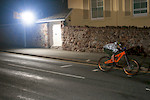InColour
- Member since Jun 15, 2010
- 0 Followers
- 0 Trailforks Points
Recent

InColour elbry's photo
Aug 9, 2010 at 4:11
Aug 9, 2010
About 1/1000th of a sec. But if you have a shutter speed of 1/50th (like the exif says), then you have lots of opportunity to get it in the shot.
Also, if you look at the EXIF then flash did not fire, so it's most likely real!

InColour advorak's article
Jun 15, 2010 at 7:04
Jun 15, 2010
Mountain Bike Spine Injuries - Some Statistics
And no, i'm sceptical because scepticism of it is the best stance to take before something has proper evidence in its favour, which Leatt doesn't.
You can't compare them to helmets/padding either. Helmets HAVE been extensively tested, it's been shown that statistically you're less likely to injure yourself when wearing one, and there are safety standards that they much reach, which have been decided by independent organisations. With helmets and padding it's simply a simple case of putting something between you and what you're about to hit, spreading the load over a larger area and increasing the impact time. It's something that's been done for thousands of years in loads of different applications.
Neck braces like this are completely new and unproven, and what they do is no where near as simple. You're actually attempting to transfer the force to somewhere completely different on the body. It still has to go somewhere. You also have to think about what your neck does in an accident; it can fold to the left or right as you impact so it's moved out of they way. There's so many more variables and the spine is so complex that it can't be compared to normal armour.

InColour advorak's article
Jun 15, 2010 at 6:51
Jun 15, 2010
Mountain Bike Spine Injuries - Some Statistics
No, they don't show they decrease the risk by 25%. They show that in that [B]specific[/b] test with that [B]specific[/B] force the compressional on the neck of a dummy is reduced by about 25%. We have no idea what happens when it isn't a dummy swung like a pendulum with a completely clean hit. We have no idea what the force on the upper back where the brace rests is in a hard impact. We have no idea if it puts your neck at extra risk of compression in situations where your head can't roll out of the way because of it. We just don't know. That's the value of peer reviewed research, of which there is none for this. That way you at least have some assurances that their claims are substantiated.
And I really do have a problem with Leatt trying to use videos like that to promote their product. With all due to respect to the guy, as awful as that situation is, he isn't an authority on the subject and he can't say whether or not it would have prevented anything.

InColour advorak's article
Jun 15, 2010 at 5:47
Jun 15, 2010
Mountain Bike Spine Injuries - Some Statistics
http://www.leatt-brace.com/gpx_testing.html
They have in no way shown that in a real world accident the brace helps. If you look at the graphs, the force from compression isn't even all that different with a brace on, which is the injury where you're most likely to damage your spinal cord. A concern i've heard raised with it a number of times is that the brace stops your head from being able to roll out the way of the ground; you kind of end up as a rigid body which digs in, increasing compressional forces. I don't see any testing by Leatt which would disprove that. My point is that in the real world it's messy; you land on uneven surfaces, the ground has give in it so things can dig in, you can hit trees, etc. After you've had an impact which could shift the position of the brace, what happens if you have a second impact? What's the increase in force on your upper back where the brace sits after having your helmet contact with the back of the collar?
I'm not saying it doesn't work, it might well do, but I really hate the way that Leatt has marketed it, as if somehow they've shown that it does actually protect athlete's necks, and trying to sell it based on the fear of an injury, particularly to parents for their kids. They even link to this video;
http://www.vitalmx.com/videos/features/A-Message-From-David-Bailey,196/GuyB,64
It's been out for a while, have they tried to do a study on its use in MX? There are enough spinal injuries in motocross to be able to produce something statistically significant after a number of years, surely?

InColour advorak's article
Jun 15, 2010 at 5:47
Jun 15, 2010
Mountain Bike Spine Injuries - Some Statistics
You really can't compare Leatts to seatbelts.
The problem I have with Leatt braces is that the only piece of research you can see that they, the people trying to sell it have done seems to be some force/torque sensors in a dummy, and then some [B]very[/B] idealised scenarios.
None of it has been published in a journal, so we just have their word that what they've done effectively models real world scenarios and takes into account other risks. If Dr Leatt actually felt like writing a research paper then perhaps I would take him a little more seriously.